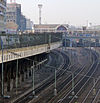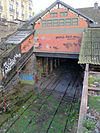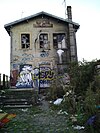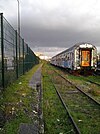Chemin de fer de Petite Ceinture

The Chemin de fer de Petite Ceinture (French for "little belt railway") was a Parisian railway that, from 1852, was a circular connection between Paris's main railway stations within the fortified walls of the city. In a partial state of abandonment since 1934, the future of its yet-undeveloped property is the subject of much debate as of 2013. Many French railway enthusiasts and associations would like to see the abandoned railway and its remaining stations preserved and protected as a part of France's national heritage.
Origins
France's first steam-locomotive-driven purely passenger Paris-Saint-Germain raliroad had opened from 1837.[1] In the years following, new railways appeared in many regions of France, but development of the new technology for the country as a whole soon became far behind its rival western European counties. From June 1842 the Louis-Philippe government-monarchy intended to close this gap with their "Legrand Star", a map of planned railway concessions that made Paris the centre of a spiderweb network of lines reaching to all regions and borders of France. By the end of the decade, and much maneuvering and dealing, France was served by five distinct railroad companies and lines, each with their own exclusive monopoly over a region of France.
Paris before the Petite Ceinture

Paris was only half its present size in the years of the Ceinture's creation: its limits then were the city's 1784 Fermiers-Généraux tax wall that followed almost exactly today's Métro lines 6 and 2). From 1841, Paris doted itself with a ring of defences a few kilometres outside these: completed in 1845, the Thiers wall fortifications enclosed land that was mostly countryside, save for a few 'faubourgs' extending for a distance along the roadways from its city gates.
In that year, Paris had five major stations, all located just inside the city tax walls, run by five railway companies: Paris-Rouen (later Ouest, near today's gare Saint-Lazare, Nord (at today's gare du Nord), Paris-Strasbourg (later Est, at today's gare de l'Est), Paris-Lyon (at today's gare de Lyon) and Paris-Orléans (at today's gare d'Austerlitz). Since the rail barons of the time were persuaded that direct connection to a competing line would endanger their control over their respective region monopolies, there was no company inter-station service of any kind: freight and passengers travelling between regions of France had no choice but to commute from station to station via roadway through the congestion of the capital.[citation needed]
A Military idea
The idea for Paris's Chemin de Fer de Petite Ceinture originated with its fortifications[2]: rail transport was still relatively new when Paris's city fortifications were completed in 1845[3], and France's Generals saw the new technology as a means to quickly move troops and material between points along the circular wall. An initial 1842 study resulted in three pre-projects for railways to the inside of the fortifications, another between the forts outside them, and another ring in a still larger diameter outside the city, but by 1845 the government's increasingly urgent priority was the Right Bank portion of the inner-fortification rails.
The government of the time was too financially burdened to undertake building and managing a railway on its own, so it depended upon France's major rail companies for financial support and management. The post-1848-revolution government was not in an any better position to negotiate, and all the Second Republic government's coercive manoeuvring managed to achieve was the rail companies making freight-exchange deals and mergers amongst themselves.[citation needed] Meanwhile, not only did the Generals not have their wall-approvisioning railway, but had no means of moving troops from one region of France to another via the capital: for them, Paris had become an obstacle.
A Ring in Three Sections
I - the Syndicated 'Chemin de Fer de Ceinture' (Rive Droite)
Napoleon III's coup d'Etat on the 2nd of December 1851 meant a new government with more grandiose visions for France's railway future. Re-opening the negotiations based on a pre-Second Empire project to connect all of Paris' railway stations through an arc of rail between the Rouen-Versailles Rive Droite (Gare-St-Lazare) and Orléans (Gare d'Austerlitz) lines, with the Versailles Rive Gauche lines (leading to today's Gare Montparnasse) joined to its Versailles-Rive Droite counterpart through a junction at Viroflay (in the suburbs to the southwest of Paris), the Rouen, Nord, Strasbourg, Orléans (then bankrupt, but state-sponsored) and Lyon companies signed participation, and the project was transformed into a decree-proposition that the Prince-President signed into law on the 10th of December 1851.[4]
In this agreement, against a 1,000,000 Franc contribution from each company, the government would organise and finance the landscaping, bridges and rails for the line, to be completed no later than two years from the concession signing. Once completed, it would be placed at the disposal of a 'Compagnie de Chemin de fer de Ceinture de Paris' (not yet Rive Droite), a syndicate comprising two members of each company, for a period of 99 years, during which they would provide a service 'for freight and passengers' using rolling stock from each company.[citation needed]
The first stretch of Parisian-station-connecting rail built wasn't part of the Ceinture concession at all, but one originating from an earlier inter-company deal which had become a separate concession of its own, an arc of rail between the Nord and Strasbourg (Est) lines: open in April 1852, it would later be connected to the first length of ceinture completed the 12 December 1852 between Rouen's Batignolles freight yards and the Pont du Nord, a point above the Nord company rails south to their station in Paris. The second Ceinture section delivered, between Pont du Nord and Aubervilliers (a point where the Nord-Strasbourg lines junctioned with the Ceinture railway), opened to service on 30 September 1853. From then, trains could travel freely between the Batignolles, La Chapelle and La Villette freight yards. The construction of the line between the Pont du Nord and Ivry (the Rive Gauche Orléans company freight yard), as it undercut the hills of Montmartre and Belleville, was more problematic: several landslides delayed the work there, but it was delivered in one track from December 1853, and was fully functional from May 1854.
II - the Ouest Company's Paris – Auteuil passenger line

The Pereire-owned Ouest company's 1852 demand for permission to build a railway running to the inside the city's western arc of fortifications was for a line that had nothing to do with the Chemin de fer de Ceinture, but the government wrote their concession-approving decree as though it were an addition to it. Quite different from the Ceinture's freight-only service, the 'Paris-Auteuil' line was to carry passengers only, namely the Parisian bourgeoisie destined for their country homes to the south-west of the city: leaving the Gare Saint-Lazare rails just to the north of the station, it arced west, then south to the still-suburban town of Auteuil.
In an effort to avoid blocking traffic (like the Ceinture Rive Droite did), it was built below ground level for most of its 9.5km length, an endeavour that required the construction of 14 bridges across its entrenched path. Besides its rue St-Lazare embarcadère terminus (also serving the Ouest company's other lines), the line had five stations: Pont-Cardinet (an SNCF station today), Courcelles (today's Pereire - Levallois RER C station), Neuilly-Porte Maillot, Avenue de l'Impératrice (Avenue Foch), Passy (Avenue Henri-Martin) and Auteuil (unused today). The Paris-Auteuil passenger line was inaugurated on 2 May 1854,[5] and began service on the 5th of June.[citation needed]
III - the Ouest Company's 'Chemin de Fer de Ceinture Rive Gauche'

From 1852 the state had continued, non-officially, a plan-study for the Left Bank arc of rail that would complete their original fortification-provision goals, and from 1857 this became an official pre-project that Napoleon III declared 'of public interest' in 1861.[6] The Ceinture Syndicate and companies saw no commercial interest in this, however: as per the concession agreements, all companies and lines were connected between them, and they had considered the case closed since the ceinture began functioning. The state, intent in their aims, had begun procuring the funds necessary to purchase the lands and lay rail for the line even before Napoleon III's declaration, and had begun the landscaping and bridge work needed for a Chemin de fer de Ceinture Rive Gauche from 1863.[citation needed]
It is worth mentioning that, in the meantime, Paris had doubled in size: from 1860, Paris annexed all the 'country communes' between its city tax walls and the fortifications, which put the formerly countryside Ceinture line within the new City limits. Serving these 'new arrondissements' with a rail service became yet another negotiating point for the state. Also added to their list of arguments was the need of a railway to the upcoming 1867 International Exposition that would bring crowds of visitors from the world over to the Left Bank Champ du Mars.[citation needed]
In earlier state-rail-company negotiations, the state had obtained the possibility of buying the Auteil line back from the Ouest company,[citation needed] and they used this as leverage to get the company to agree to signing a Ceinture Rive Gauche concession convention on the 31st of May 1865.[citation needed] In this agreement the state would complete the landscaping and bridges needed for the line, return the Auteuil-line concession to the Ouest company (this time permanently) along with the Rive Gauche line, as well as the concession of an 'eventual' connection to the Ceinture Rive Droite at Batignolles; all the same, the state reserved, within a delay of eight years, to purchase some or all of the concession in case ongoing plans for a 'métropolitan' railway line went through. The Ouest company, on their side of the agreement, would lay the rail, provide all the buildings, and execute and maintain the rail service; also part of the agreement was the 'temporary' extension of line between the Left Bank 'Grenelle' station and the Champ du Mars, as well as make the modifications to their Auteuil line required for freight transport.[citation needed]
The Ceinture Rive Gauche line began service on the 25 February 1867,[citation needed] and the 'temporary' Grenelle-Champ du Mars portion of track entered service two days later. All that remained was the portion of rail connecting the Auteuil lines to the Ceinture Rive Droite under the railway lines from the (rebuilt and renamed since 1853) Gare St-Lazare: the underpass construction began in February 1867, and it and its new station, Courcelles-Ceinture, began service from the 25th of March 1869.[citation needed]
The Ceinture Rive Gauche underwent further modifications for the 1889 Universal Exposition: its many level crossings were removed, and its Grenelle-Champ du Mars extension was rebuilt, this time permanently.[citation needed] The last major addition to the line would be, for the 1900 Universal Exposition, a new bridge and the rail that would allow trains from the Paris-Auteuil line 'Passy' station to cross the river directly to the Champ du Mars.[citation needed]
Ceinture Service

The early years
In November 1856, four Est-company locomotives (and one in reserve) were enough to provide freight service between the city's rail company freight yards, and trains were composed of company-owned freight cars. Most often, freight, travelling the Ceinture in the wagons belonging to the company that brought it to the capital, once arriving at the freight-yard of the company taking it elsewhere in France, was transferred to that company's wagons, an onerous process. The Ceinture service was at first reserved for only 'main station' companies, but from the 1st of September 1855 opened to local merchants recieving goods, and two freight stations, 'Ceinture de Charonne' and 'La Petite Villette', opened in 1855 an 1856, respectively. Service at first was only during daytime hours, but from 1857, ran at night as well. From 1859, the North company took over providing locomotion with seven new 040 T engines that would become the signature Ceinture engine.
The Ceinture Rive Droite concession stipulated that the railway should be open to passengers as well, but the companies resisted all state pressure to this end until 1862, when they opened five hastily-built passenger stations: 'Batignolles-Clichy', 'Belleville-Villette' (near the "La Petite Villette" freight station), 'Ménilmontant', and 'Charonne' (in the existing Charonne freight yard), and 'La Rapée-Bercy'. Two others, 'La Chapelle-Saint-Denis' and 'Bel Air', opened before two years later; the latter would be the the line's first 'correspondence' point, where travellers could transfer to the Est-owned 'Paris-Vincennes' trains headed to and from its place de la Bastille terminus. The Ceinture-Syndicate-owned passenger cars were two-level 'Impériales' pulled by two 030 'Mammouth' locomotives, and service was one train in each direction every two hours. Extra trains were added on holidays, and from 1866, to serve local factories, reduced-price morning and evening 'worker trains' as well.
Meanwhile, the passenger-only Paris-Auteuil line had been running trains every half hour in the mornings, and every twenty minutes in the afternoon, between its Saint-Lazare terminus, 'Batignolles-Clichy', 'Courcelles-Levallois', Neuilly-Porte Maillot', 'Avenue de l'Impératrice' (later 'avenue Foch'), 'Passy' and 'Auteuil' (terminus) stations since its 1854 opening. From 1866, in preparation for its connection to the Ceinture Rive Gauche, its quays were lowered, and a new Auteuil terminal, lateral to the first, took trains from the Saint-Lazare station, creating a correspondance with the old platforms that were from then dedicated to Ceinture Rive Gauche service.
The also-Ouest-owned Ceinture Rive Gauche's stations were: From the Auteuil terminus, the 'Point du Jour' station on the new viaduct across the river Seine, 'Grenelle' (where passengers could transfer to a shuttle to the Champ du Mars), Ouest-Ceinture (correspondence with the Ouest lines to their Paris-Versailles Rive Gauche station), 'Montrouge', 'Gentilly' (correspondance with the 'Paris-Sceaux' line to its Denfert-Rochereau terminus), 'Maison Blanche', and 'Orléans-Ceinture' (correspondance with the Orléans line to today's Gare d'Austerlitz). From its 1866 opening to passenger-only service, the entire line ran alternating Ceinture Syndicate and Ouest trains between the Ceinture line's then 'Avenue de Clichy' (formerly 'Batignolles-Clichy') and 'Auteuil' terminus at a rate of one train an hour in each direction, and at a rate of one every half-hour on Sundays and holidays. The entire 33-kilometer trip, with its 21 stops, took, at best, 1h50 then.
While planning a unique slaughterhouse near La Villette in 1859 to replace those existing within the city walls, Napoleon III expressed his desire they be connected to the Ceinture by rail, a plan that became a concession and decree on the 19th of October 1864.[7] It was a stretch of rail that, after leaving the Ceinture to either side of the Belleville-Villette station to form a triangle to its east, arced northward to two stations, 'Paris Bestiaux' in the slaughterhouse marketplace and, further on to the other side of the drawbridged canal, 'Paris Abattoirs' in the slaughterhouse complex itself. The antenna and stations were open to service from the 18th of October 1867, three days before the inauguration of the slaughterhouses themselves.
The completion of the Courcelles underpass and its 'Courcelles-Ceinture' station for the 1867 Universal Exposition meant that trains could travel in a full circle around Paris without correspondence; although the Ceinture's terminuses moved to 'Courcelles-Ceinture' and 'Batignolles-Clichy', but trains did not travel in a full non-terminus circle then. Also for the Universal Exposition, the Ceinture Rive Droite doted its line with two new temporary 'for-exposition correspondence' stations, 'Est-Ceinture' (where the ceinture crossed the lines to the gare de l'Est) and 'Bercy-Ceinture' over the gare de Lyon lines (that was dismantled after the exposition end) stations appeared, and four new permanent stations: 'Saint-Ouen', 'Boulevard Ornano', 'Pont de Flandre', and 'Avenue de Vincennes'. Replacing the Nord company, the Ceinture Syndicate bought and ran its own 040 T locomotives from 1869, which were stored and maintained in new hangars near the Chapelle-Saint-Denis freight yards.
Growing Pains
The Chemin de Fer de Ceinture served its military purpose when it was requisitioned by the state for the 1870 Prussian war and siege of Paris. The Ceinture Rive Droite was only slightly damaged from Prussian bombardments from the north, but the Auteuil and Ceinture Rive Gauche lines were heavily damaged in the 1870-71 Commune civil war that followed: the 'Neuilly-Porte Maillot' station was completely destroyed, the Auteuil terminus mostly destroyed, and the Auteuil viaduct and 'Grenelle' station were heavily damaged. After the conflict's end, at first only in sections with trains every hour, Ceinture service returned to its half-hour cadence, begun just before the war, from the 16th of July 1871.
The Chemin de fer de Ceinture Rive Gauche was still a passenger only line then, from 1874 a junction between the Ouest lines near the Ceinture 'Vaugirard' station allowed trains a shortcut from the bifurcation at Viroflay. The Ouest company had opened a 'Reuilly' freight station off of its Paris-Vincennes line in 1877, and the Ceinture Rive Gauche 'Bel-Air' junction opened to freight service two years later. The Ceinture Rive Gauche's first dedicated-freight station, 'Grenelle-Marchandises', also opened in 1879.
The Chemin de Fer de Ceinture's passenger traffic was on the uprise then, and it was expected to be higher for the upcoming 1878 Universal Exposition. The Nord and Paris-Lyon-Méditerranée lines still had no passenger correspondence points with the Ceinture, but this changed with the 1875 opening of the Nord-line 'Nord Ceinture' station near the Ceinture's 'La Chapelle-Saint-Denis' station, and the Paris-Lyon-Méditerranée's 'Bercy-Ceinture' station on their lines near the Ceinture 'La Rapée-Bercy' station, and Est-Ceinture re-opened from the 15th of May 1878. The Paris-Vincennes line added a second arc of rail to the first one at Bel-Air that allowed trains to travel to and from Bastille in both directions from 1878, and the Ouest company rebuilt a new antenna to the Champ du Mars (replacing the one dismantled in 1869), but this time permanently as a part of an upcoming 'Paris-Moulineaux' suburban railway line that was to have its terminus at the Pont d'Alma. The Paris-Auteuil line also built a new station for the exposition, 'Avenue du Trocadéro'. With the temporary addition of the Est company's Paris-Vincennes trains to the Ceinture schedule, its train cadence for the duration of the Exposition rose to one every fifteen minutes, and passengers to the Champ du Mars depassed 50,000 per day.
The Ceinture Syndicate, pleased with Exposition results, after a period of experimentation after the Est company withdrew its trains at the Exposition's end, decided to make the fifteen-minute service permanent from 1881, and from the following year, the Paris-Auteuil section topped its service to create a cadence of 4-8 trains an hour. This called for a total suppression of freight traffic at certain times at certain points along the Ceinture Rive Droite line. The Ceinture Rive Gauche's freight service was still insufficient for local commerce, though, and this led to the opening of a new 'Glacière-Gentilly' freight yard from 1882.
Line congestion was already a problem then, and a plan to build a 'Chemin de fer de Grande Ceinture' extra-muros railway ring had already been underway since 1875. The company least concerned with freight matters, the Ouest, had abstained from the agreement, but in 1880 proposed merging the two Ceinture syndicates (Petite and Grande): this would allow the companies to transfer their freight traffic to the outer ring and dedicate the inner ring to passenger and Parisian-commerce-destined freight traffic. In exchange for its participation, the Ouest offered its Ceinture Rive Gauche and Courcelles bifurcation concessions, but demanded that its Paris-Auteuil line be exempt from it: this agreement was approved by decree on the 11th of November 1881, and active from April 1883.
La Belle Époque
Abandonment
Service for the Champ de Mars extension was discontinued from 1924, and passenger service for the Ceinture Rive Gauche and Rive Droite sections ended in 1934. Electrified from 1925, the Auteuil line remained open until 1985. The connection between Gare du Nord and Gare de l'Est was in use until the 2000s but (as of 2011) has seen use fall dramatically. Passenger and freight service from both stations are hauled by engines from the SNCF depots at La Chapelle and Pantin, seldom exchanging rolling stock. The Grande Ceinture is currently used to swap stock and as a diversion line.

When plans to reanimate Paris' tramway in a ring encircling Paris began from 1995,[citation needed] re-using parts of the Petite Ceinture as was under serious consideration, but the planning board opted for a line along the Boulevards des Maréchaux (Boulevards of the Marshals, a ring of boulevards, formerly a road to the inside of the City's former 'Fortifications' defences) were opted for instead. The first of these 'Maréchaux' tram lines, Line 3, was inaugurated on the 16th of December 2006.[citation needed]
Access to the unused rail tracks is forbidden, but enthusiasts explore it nonetheless, describing it as a quiet, natural garden space within Paris.[8]
Reuse and Actual State
Re-use by the RER C
The Ligne d'Auteuil closed in 1985 to make way for the newly opened Réseau Express Régional (RER) C line. The RER C has been extended to Montigny-Beauchamp and Argenteuil after the construction of a new tunnel crossing northwest Paris. The line branches off at Champ de Mars, crossing the Seine. From there the line is underground; the Ligne d'Auteuil was covered in 1988, and the line between Henri Martin and Courcelles was reduced from four tracks to two. It exits Paris in a tunnel ending in Clichy.
List of Ceinture Stations - Actual State
| |||||||||||||||||||||||||||||||||||||||||||||||||||||||||||||||||||||||||||||||||||||||||||||||||||||||||||||||||||||||||||||||||||||||||||||||||||||||||||||||||||||||||||||||||||||||||||||||||||||||||||||||||||||||||||||||||||||||||||||||||||||||||||||||||||
|---|---|---|---|---|---|---|---|---|---|---|---|---|---|---|---|---|---|---|---|---|---|---|---|---|---|---|---|---|---|---|---|---|---|---|---|---|---|---|---|---|---|---|---|---|---|---|---|---|---|---|---|---|---|---|---|---|---|---|---|---|---|---|---|---|---|---|---|---|---|---|---|---|---|---|---|---|---|---|---|---|---|---|---|---|---|---|---|---|---|---|---|---|---|---|---|---|---|---|---|---|---|---|---|---|---|---|---|---|---|---|---|---|---|---|---|---|---|---|---|---|---|---|---|---|---|---|---|---|---|---|---|---|---|---|---|---|---|---|---|---|---|---|---|---|---|---|---|---|---|---|---|---|---|---|---|---|---|---|---|---|---|---|---|---|---|---|---|---|---|---|---|---|---|---|---|---|---|---|---|---|---|---|---|---|---|---|---|---|---|---|---|---|---|---|---|---|---|---|---|---|---|---|---|---|---|---|---|---|---|---|---|---|---|---|---|---|---|---|---|---|---|---|---|---|---|---|---|---|---|---|---|---|---|---|---|---|---|---|---|---|---|---|---|---|---|---|---|---|---|---|---|---|---|---|---|---|---|---|---|
|
References
- ^ M. Nilsen 2008, p. 82.
- ^ Lepage 2005, p. 177.
- ^ Lepage 2005, p. 179.
- ^ Bulletin des Lois 1851 1853, p. 447.
- ^ Auguste Perdonnet 1865, p. 210.
- ^ Bulletin des Lois 1861 1862, p. 253.
- ^ Bulletin des Lois 1864 1866, p. 171.
- ^ "The wild abandoned railway in the centre of Paris", BBC News, 25 October 2013
Bibliography
- Bulletin des Lois 1851 (1853). Bulletin des lois de la République franc̜aise (in French). Imprimerie nationale.
{{cite book}}: Invalid|ref=harv(help)CS1 maint: numeric names: authors list (link) - Bulletin des Lois 1861 (1862). Bulletin des lois de l'Empire Français (in French). la République.
{{cite book}}: Invalid|ref=harv(help)CS1 maint: numeric names: authors list (link) - Bulletin des Lois 1864 (1866). Bulletin des lois (in French). Imprimerie Royale.
{{cite book}}: Invalid|ref=harv(help)CS1 maint: numeric names: authors list (link) - Bruno Carrière (1992). La saga de la petite ceinture (in French). Ed. La Vie du Rail. ISBN 978-2-902808-36-6.
{{cite book}}: Invalid|ref=harv(help) - Jean-Denis G.G. Lepage (8 December 2005). The Fortifications of Paris: An Illustrated History. McFarland. ISBN 978-0-7864-5829-5.
{{cite book}}: Invalid|ref=harv(help) - M. Nilsen (13 October 2008). Railways and the Western European Capitals: Studies of Implantation in London, Paris, Berlin, and Brussels. Springer. ISBN 978-0-230-61577-9.
{{cite book}}: Invalid|ref=harv(help) - Auguste Perdonnet (1865). Traite elementaire des chemins de fer: 1 (in French). Garnier.
{{cite book}}: Invalid|ref=harv(help) - Histoire du réseau ferroviaire français, 1996, Editions de l'Ormet / Imprimerie Bayeusienne Graphique. ISBN 2-906575-22-4 Template:Fr icon
External links
![]() Geographic data related to Chemin de fer de Petite Ceinture at OpenStreetMap
Geographic data related to Chemin de fer de Petite Ceinture at OpenStreetMap
- Illustrated review of Georges Méliès' 1898 film Panorama from Top of a Moving Train (Panorama pris d’un train en marche), believed to have been filmed along the route, but actually filmed from a train of the Chemin de fer de Vincennes, which crosses the Petite ceinture at Bel-Air.
- BBC article and video about the Little Belt































































